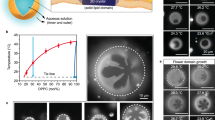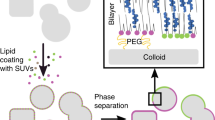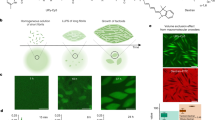Abstract
Osmotic shock in a vesicle or cell is the stress build-up and subsequent rupture of the phospholipid membrane that occurs when a relatively high concentration of salt is unable to cross the membrane and instead an inflow of water alleviates the salt concentration gradient. This is a well-known failure mechanism for cells and vesicles (for example, hypotonic shock) and metal alloys (for example, hydrogen embrittlement)1,2,3. We propose the concept of collective osmotic shock, whereby a coordinated explosive fracture resulting from multiplexing the singular effects of osmotic shock at discrete sites within an ordered material results in regular bicontinuous structures. The concept is demonstrated here using self-assembled block copolymer micelles, yet it is applicable to organized heterogeneous materials where a minority component can be selectively degraded and solvated whilst ensconced in a matrix capable of plastic deformation. We discuss the application of these self-supported, perforated multilayer materials in photonics, nanofiltration and optoelectronics.
This is a preview of subscription content, access via your institution
Access options
Subscribe to this journal
Receive 12 print issues and online access
$259.00 per year
only $21.58 per issue
Buy this article
- Purchase on Springer Link
- Instant access to full article PDF
Prices may be subject to local taxes which are calculated during checkout



Similar content being viewed by others
References
Gordeev, Y. N. & Entov, V. M. Osmotic mechanism of fracture growth in saturated porous media. Fluid Dyn. 36, 964–970 (2001).
Olbrich, K., Rawicz, W., Needham, D. & Evans, E. Water permeability and mechanical strength of polyunsaturated lipid bilayers. Biophys. J. 79, 321–327 (2000).
Sargent, J. P. & Ashbee, K. H. G. The contribution of osmosis to dimensional instability of adhesive joints. J. Adhes. 17, 83–93 (1984).
Fozza, A. C., Klemberg-Sapieha, J. E. & Wertheimer, M. R. Vacuum ultraviolet irradiation of polymers. Plasmas Polym. 4, 183–206 (1999).
Kramer, E. J., Yokoyama, H. & Mates, T. E. Structure of asymmetric diblock copolymers in thin films. Macromolecules 33, 1888–1898 (2000).
Menelle, A., Russell, T. P., Anastasiadis, S. H., Satija, S. K. & Majkrzak, C. F. Ordering of thin diblock copolymer films. Phys. Rev. Lett. 68, 67–70 (1992).
Stein, G. E., Kramer, E. J., Li, X. F. & Wang, J. Layering transitions in thin films of spherical-domain block copolymers. Macromolecules 40, 2453–2460 (2007).
Smolders, C. A., Reuvers, A. J., Boom, R. M. & Wienk, I. M. Microstructures in phase-inversion membranes. Part 1. Formation of macrovoids. J. Membr. Sci. 73, 259–275 (1992).
Hillmyer, M. A. Nanoporous materials from block copolymer precursors. Adv. Polym. Sci. 190, 137–181 (2005).
Lu, Y. F. et al. Aerosol-assisted self-assembly of mesostructured spherical nanoparticles. Nature 398, 223–226 (1999).
Melde, B. J., Holland, B. T., Blanford, C. F. & Stein, A. Mesoporous sieves with unified hybrid inorganic/organic frameworks. Chem. Mater. 11, 3302–3308 (1999).
Hashimoto, T., Tsutsumi, K. & Funaki, Y. Nanoprocessing based on bicontinuous microdomains of block copolymers: Nanochannels coated with metals. Langmuir 13, 6869–6872 (1997).
Zalusky, A. S., Olayo-Valles, R., Wolf, J. H. & Hillmyer, M. A. Ordered nanoporous polymers from polystyrene-polylactide block copolymers. J. Am. Chem. Soc. 124, 12761–12773 (2002).
Chan, V. Z. H. et al. Ordered bicontinuous nanoporous and nanorelief ceramic films from self assembling polymer precursors. Science 286, 1716–1719 (1999).
Crossland, E. J. W. et al. A bicontinuous double gyroid hybrid solar cell. Nano Lett. 9, 2807–2812 (2009).
Wang, Y. & Li, F. B. An emerging pore-making strategy: Confined swelling-induced pore generation in block copolymer materials. Adv. Mater. 23, 2134–2148 (2011).
Yokoyama, H. & Zhang, R. Fabrication of nanoporous structures in block copolymer using selective solvent assisted with compressed carbon dioxide. Macromolecules 42, 3559–3564 (2009).
Hedrick, J. L. et al. Polyimide nanofoams from aliphatic polyester-based copolymers. Chem. Mater. 10, 39–49 (1998).
Eshelby, J. D. The force on an elastic singularity. Phil. Trans. R. Soc. A 244, 87–112 (1951).
Thomas, N. L. & Windle, A. H. A theory of case II diffusion. Polymer 23, 529–542 (1982).
Sharp, J. S. & Bailey, J. Infrared dielectric mirrors based on thin film multilayers of polystyrene and polyvinylpyrrolidone. J. Polym. Sci. Polym. Phys. 49, 732–739 (2011).
Thomas, E. L. et al. Polymer-based photonic crystals. Adv. Mater. 13, 421–425 (2001).
Peinemann, K. V., Abetz, V. & Simon, P. F. W. Asymmetric superstructure formed in a block copolymer via phase separation. Nature Mater. 6, 992–996 (2007).
Yang, S. Y. et al. Nanoporous membranes with ultrahigh selectivity and flux for the filtration of viruses. Adv. Mater. 18, 709–712 (2006).
Phillip, W. A., O’Neill, B., Rodwogin, M., Hillmyer, M. A. & Cussler, E. L. Self-assembled block copolymer thin films as water filtration membranes. ACS Appl. Mater. Interfaces 2, 847–853 (2010).
Alberius, P. C. A. et al. General predictive syntheses of cubic, hexagonal, and lamellar silica and titania mesostructured thin films. Chem. Mater. 14, 3284–3294 (2002).
Kabra, D., Song, M. H., Wenger, B., Friend, R. H. & Snaith, H. J. High efficiency composite metal oxide-polymer electroluminescent devices: A morphological and material based investigation. Adv. Mater. 20, 3447–3452 (2008).
Rungsawang, R. et al. Magnetically induced pattern formation in phase separating polymer–solvent–nanoparticle mixtures. Phys. Rev. Lett. 104, 255703 (2010).
Zentel, R. & Fleischhaker, F. Photonic crystals from core–shell colloids with incorporated highly fluorescent quantum dots. Chem. Mater. 17, 1346–1351 (2005).
Turberfield, A. J., Campbell, M., Sharp, D. N., Harrison, M. T. & Denning, R. G. Fabrication of photonic crystals for the visible spectrum by holographic lithography. Nature 404, 53–56 (2000).
Novoselov, K. S. et al. Electric field effect in atomically thin carbon films. Science 306, 666–669 (2004).
Lozano, G., Colodrero, S., Caulier, O., Calvo, M. E. & Miguez, H. Theoretical analysis of the performance of one-dimensional photonic crystal-based dye-sensitized solar cells. J. Phys. Chem. C 114, 3681–3687 (2010).
Perez, M. D. et al. Growth of gold nanoparticle arrays in TiO2 mesoporous matrixes. Langmuir 20, 6879–6886 (2004).
Acknowledgements
We would like to acknowledge S. Vignolini, C. Wang (beamline 11.0.1.2, LBNL), S. Alvarez, C. Lopez and Q. Song, and the insightful comments of U. Steiner and E. J. Kramer. This work was funded by the Qatar Foundation (QNRF), the Engineering and Physical Sciences Research Council (EPSRC), the Consejo Nacional de Ciencia y Tecnología (CONACyT), the Spanish Ministerio de Ciencia e Innovación (MICINN, Consolider HOPE) and the Government of Andalucía.
Author information
Authors and Affiliations
Contributions
All authors participated in discussions of the research and wrote the manuscript. P.Z-R., K.C., V.N. and E.S. contributed to structural characterization and phenomenology of the COS effects, S.K.N. and S.A.A-M. developed the filtration studies, D.K. and R.H.F. developed the optoelectronic application, H.M. and M.E.C. developed the photonic applications and A.H. provided X-ray characterization of the COS structures.
Corresponding author
Ethics declarations
Competing interests
The authors declare no competing financial interests.
Supplementary information
Supplementary Information
Supplementary Information (PDF 2818 kb)
Rights and permissions
About this article
Cite this article
Zavala-Rivera, P., Channon, K., Nguyen, V. et al. Collective osmotic shock in ordered materials. Nature Mater 11, 53–57 (2012). https://doi.org/10.1038/nmat3179
Received:
Accepted:
Published:
Issue Date:
DOI: https://doi.org/10.1038/nmat3179
This article is cited by
-
Highly CO2-permeable membranes derived from a midblock-sulfonated multiblock polymer after submersion in water
NPG Asia Materials (2019)
-
In situ inward epitaxial growth of bulk macroporous single crystals
Nature Communications (2017)
-
Giant Gyroid and Templates from High-Molecular-Weight Block Copolymer Self-assembly
Scientific Reports (2016)
-
Design and fabrication of far ultraviolet filters based on π-multilayer technology in high-k materials
Scientific Reports (2015)
-
Polymeric molecular sieve membranes via in situ cross-linking of non-porous polymer membrane templates
Nature Communications (2014)



